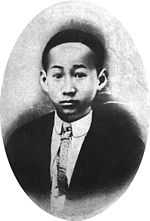Lu Hao-tung

Lu Hao-tung (Chinese: 陸皓東; pinyin: Lù Hàodōng) (1868–1895), born Lu Chung-gui (中桂 Zhōngguì), courtesy name Hsien-hsiang (獻香 Xiànxiāng), was the first "revolutionary martyr" of the Republic of China. In the same year he died, he designed the "Blue Sky with a White Sun" emblem that came to be used as the Kuomintang (KMT) party flag, national emblem of the Republic of China, and the canton of the flag of the Republic of China.
Born in Cuiheng Village, Xiangshan County, Guangdong, Lu Hao-tung had been a playmate and close friend of Sun Yat-sen since they were classmates at the Lu-shi Ancestral Temple (陸氏祖祠) school. They deliberately damaged the statue of the god Pak Tai, and were scorned by the villagers. Lu fled the village after this incident, and arrived at Shanghai later to study at the Shanghai Telegram School (學堂). During that time, he worked for the Wuhu Telegram Office (蕪湖電報局).
He returned to the village in 1890, and met other revolutionaries. Five years later, whilst participating in the First Guangzhou Uprising, he was arrested and ultimately executed by the Qing Empire when information was leaked out.
Lu is portrayed as the character Luk Ho Dung in the film Once Upon a Time in China II, in which he is killed by Manchu soldiers while trying to escape Guangdong with the help of Wong Fei Hung.
See also
| Wikimedia Commons has media related to Lu Hao-tung. |